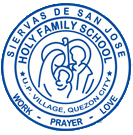Holy Family School of Quezon City
| Holy Family School of Quezon City | |
|---|---|
 | |
| Motto | Work, Prayer, Love |
| Established | 1966 |
| Type | Private, Catholic |
| Founder | Servants of St. Joseph |
| Location |
66 Maginhawa Street UP Village, Diliman, Quezon City, Metro Manila, Philippines |
| School Directress | Teresita Arcos - Surot |
| Website |
www |
Holy Family School of Quezon City, Inc. is a Catholic School for girls. It is located at 66 Maginhawa Street, UP Village, Quezon City.
The school’s foundation dates back in 1959 when Mo. Maria Valentina Ayerra, SSJ, then superior of the Holy Family Dormitory-Manila, procured the lot for Holy Family School. Inspired by the desire to share their Charism through education apostolate, the SSJ sisters started the construction of the school building in 1966.
A long period of stability and growth followed.
1966 The school opened with fifty pupils, boys and girls. There were only two available classrooms where first classes were held by the pioneer teachers Miss Elma Tuzon (later became Sr. Elma Tuzon, SSJ), Sr. Maria Flora Perez, SSJ, Sr. Filomena Cabrera, SSJ and Miss Teresita Origenes. The first superior was Mo. Carmen Enriquez, SSJ and the first principal was Sr. Jacinta Salazar, SSJ. The school accepted boys for pre-school until mid-‘80s but it was discontinued due to the limited number of classrooms and the priority given to girls.
1968 – 1974 Through the Holy Family Clinic and Holy Family School Branch the school extended its services to residents of barrio San Vicente. Moreover, selected fourth year students gave Catechetics to pupils of Pinyahan Elementary School one hour weekly. For two years, the school offered Vocational Course to the ‘yayas’ of the pre-school pupils and to other helpers who wished to learn dressmaking.
1971 The construction of school building was completed. The four storey building provides space for teaching facilities and administrative offices for both elementary and high school.
1975 A house was built within the compound for working girls and some faculty members in order to live and promote the Josephine Spirituality.
1985 – 1989 Aside from the basic academics and curricular programs, the school gave educational assistance to a large number of elementary and high school students from poor families. Free late afternoon classes were offered to cater to the needs of working students.
1991 On the school’s Silver Jubilee year, the Educational Assistance Program (EAP) was revitalized and expanded. The EAP assisted the poor but deserving students even beyond tuition needs. The program included Shop classes and income generating projects to enable recipients and their families to help themselves.
1993 Upon the imperatives of the congregation’s “Taller Document”, the school revised its Vision-Mission and started undertaking a program of redirection. The program entailed a realignment of the school’s policies and programs to its new Vision-Mission.
2004 The school continues its redirection process towards the fulfillment of its apostolic goals. In an effort to establish a particular reform, lay empowerment was undertaken, thus, the school came under the lay leadership in the same year. Mrs. Nela C. Wei was named the first lay directress.
2008 - 2009 The institution underwent a process of renewal and reorganization which included the revisiting and revising of the Vision, Mission, Goals and Objectives as well the different school programs and policies.
2011 The school began accepting again boys for pre-school. Eleven boys signed up for Kinder 1 and 2 classes.
2013 Mrs. Teresita Arcos-surot succeeded as the second lay directress. As Holy Family School approaches its Golden Jubilee Year in 2016, initiatives to meet National Quality Frameworks and Philippine Catholic School Standards are underway.
Today Holy Family School admits one thousand students from pre-school to fourth year. It has seven departments with eighty nine Faculty, Staff and SSJ sisters working collaboratively in providing quality Catholic basic education to learners in a safe and nurturing 21st century learning environment.
References
External links
| ||||||||||||||